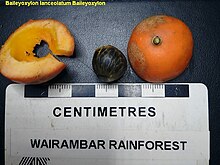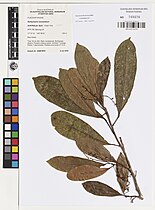
Austrobaileya is the sole genus consisting of a single species that constitutes the entire flowering plant family Austrobaileyaceae. The species Austrobaileya scandens grows naturally only in the Wet Tropics rainforests of northeastern Queensland, Australia.

Agathis robusta, commonly known as Dundathu pine, kauri pine, Queensland kauri (pine), Australian kauri (pine) or smooth-barked kauri, is a coniferous tree in the family Araucariaceae. Although sometimes called a pine it is not a true pine, having leaves rather than needles. It has a disjunct distribution, occurring in eastern New Guinea and New Britain in Papua New Guinea and Queensland, Australia.
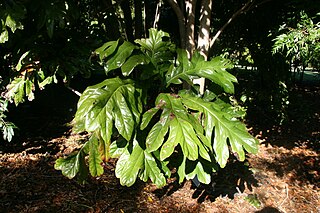
Athertonia is a monotypic genus of plants in the family Proteaceae. The sole described species is Athertonia diversifolia, commonly known as Atherton oak, athertonia, creamy silky oak or white oak. It is endemic to a small part of the Wet Tropics of Queensland, Australia. A relative of the macadamia, it has potential in horticulture and the bushfood industry.

Neolitsea dealbata, also known as white bolly gum, hairy-leaved bolly gum, or simply bolly gum, is a shrub or small tree in the laurel family Lauraceae which is native to New South Wales and Queensland in Australia.

Normanbya is a monotypic genus of palms containing the single species Normanbya normanbyi, which is known by the common name black palm It is endemic to Queensland, Australia and is threatened by habitat destruction.

Alpinia caerulea, commonly known as native ginger or Australian ginger, is an understorey perennial herb in the family Zingiberaceae which grows in rainforest, gallery forest and wet sclerophyll forest in eastern Australia.

Cyril Tenison White was an Australian botanist.

Peripentadenia is a genus of two species of large trees from the family Elaeocarpaceae endemic to the rainforests of northeastern Queensland, Australia. Sometimes they have the common name quandong.

Gardenia actinocarpa is a rare and endangered plant in the coffee and gardenia family Rubiaceae, native to a very restricted area within the Wet Tropics rainforest of northeastern Queensland.

Argophyllum curtum is a plant in the Argophyllaceae family endemic to a small part of north eastern Queensland. It was described and named in 2018.
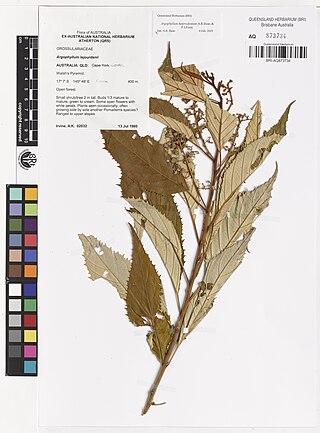
Argophyllum heterodontum is a plant in the Argophyllaceae family endemic to a small part of north eastern Queensland. It has an affinity to A. lejourdanii and was described and named in 2018.

Syzygium unipunctatum, commonly known as the rolypoly satinash, is a small tree in the family Myrtaceae. It is endemic to the rainforests of the Wet Tropics of Queensland.

Pittosporum ferrugineum, commonly known as the rusty pittosporum or rusty-leaved pittosporum, is an evergreen plant in the family Pittosporaceae native to Malesia, Papuasia, the Northern Territory and Queensland.

Argophyllum cryptophlebum is a plant in the Argophyllaceae family of the order Asterales, which is endemic to a small part of north eastern Queensland. It was described and named in 1907.

Gillbeea adenopetala, commonly known as Pink alder, is an evergreen tree in the largely southern hemisphere family Cunoniaceae. It was first described in 1865 and is endemic to a small part of Queensland, Australia.

Diploglottis bernieana, commonly known as Bernie's tamarind or large leaf tamarind, is a plant in the maple and lychee family Sapindaceae. It was first described in 1987 by the Australian botanist Sally T. Reynolds and is found only the Wet Tropics region of northeastern Queensland, Australia.
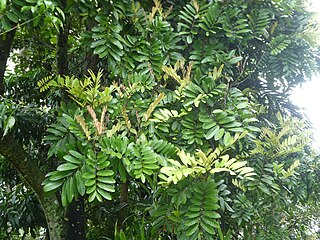
Diploglottis alaticarpa is a plant in the maple and lychee family Sapindaceae which is endemic to northeast Queensland, Australia. It was first recognised as a distinct species in 1994 and was formally described in 2014.

Aglaia ferruginea, commonly known as rusty boodyarra or rusty Aglaia, is a plant in the mahogany family Meliaceae that is native to northern Queensland, Australia. The name A. tomentosa has been misapplied to the species in the past.
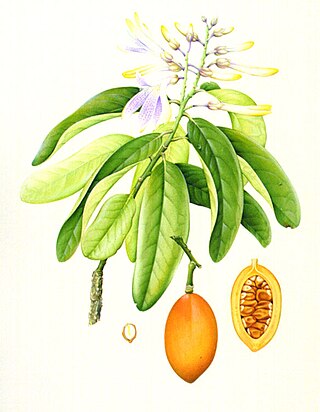
Xanthophyllum fragrans, commonly known as fragrant boxwood, is an evergreen plant in the family Polygalaceae found only in the Wet Tropics bioregion of Queensland, Australia.

Lepiderema sericolignis, commonly known as silkwood, is a plant in the maple and lychee family Sapindaceae found only in the Wet Tropics bioregion of Queensland, Australia.
